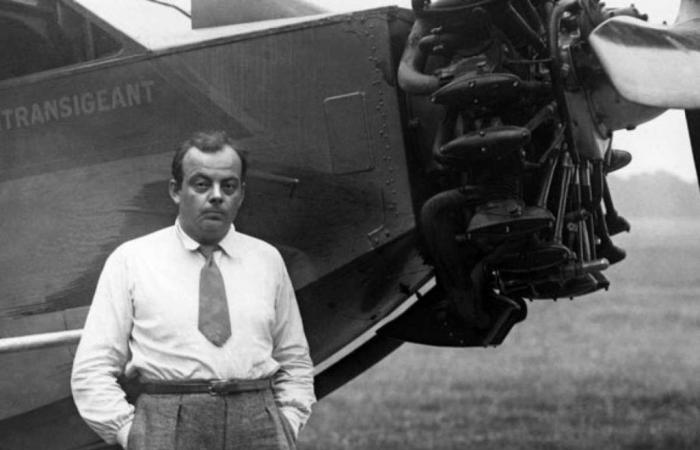“The hills under the plane were already digging their furrow of shadow in the gold of the sunset. The plains became luminous, but with an inexhaustible light: in this country they did not stop exhaling their gold, just as, once winter was over, they did not stop delivering their snow. These words were written by Antoine de Saint-Exupéry years before creating The little Prince. so it begins Night flighthis second novel, and that “country” is nothing more and nothing less than Argentina.
And the French writer and pilot arrived in Buenos Aires almost 95 years ago, on October 12, 1929. He already had aerial experience in his country and in Africa, when he accepted the position of technical director of the Aeroposta Argentina company. to make a new route that would link the country’s capital with Comodoro Rivadavia, and then extend to Río Gallegos and Tierra del Fuego.
Between Buenos Aires streets
On a plaque in the Güemes Gallery, in the heart of downtown Buenos Aires, you can read: “Antoine de Saint-Exupéry lived in this building between 1929-1930.” In fact, the apartment 605 that he rented in the construction of domes and marble in Florida at 165 was – apart from the Majestic Hotel – the author’s home during his stay in the country.
Saint-Exupéry with his colleague Henri Guillaumet and his wife in an amusement park in Buenos Aires.
It was nearby that one day, while browsing books in a bookstore, he met Luis Saslavsky, one of the greatest directors of the Golden Age of Argentine cinema. The friendship with the director continued even beyond his stay in Argentina. She suggested him as a consultant for the Hollywood adaptation of Night flight. The letters between them continued until Saint-Exupéry’s last days.
But bookstores were not the only thing the pilot frequented during his days in the country. He was known for attending cabarets such as the Tabaris and the Armenonville alongside his colleagues, Henri Guillaumet and Jean Mermoz, and soon became a regular listener of tango. “It is true that I like Argentine tango. It is such sad music…” he commented in one of his letters. It would not be strange to think that he may have seen Carlos Gardel on one of his walks.
The Saintex circle, as they called it, expanded even further. Saslavsky introduced her to María Rosa Oliver, an Argentine writer, essayist and activist who curiously descended from San Martín himself. She, belonging to the Buenos Aires elite, introduced her in turn to her close friend Victoria Ocampo. He went to Villa Ocampo, still standing in Beccar. However, it is said that their meeting was not entirely fortuitous.
The relationship with the Salvadoran writer and artist Consuelo Suncin de Sandoval began in Buenos Aires.
The one with whom there was an almost instantaneous connection was with Consuelo Suncin de Sandoval. She was a Salvadoran writer and artist who had been widowed for the second time at just 25 years old and had recently moved to Buenos Aires. They both had a mutual friend, Benjamin Crémieux, who introduced them.
After a meeting, Saint-Exupéry invited her to fly. While they were in the air, he asked her for a kiss, but she did not agree, after which the pilot threatened to crash the plane. Consuelo ended up accepting. They both got married in France and had a relationship as turbulent as its beginning, in the midst of his intense work and his many lovers. However, they maintained the bond over the years. It was she who inspired the Rose of The little Prince.
Flying over Patagonia
Saint-Exupéry had to stay in Buenos Aires, but he did not like large metropolises. Instead, he was attracted to the “strange small towns, made of corrugated metal and people who, by dint of being cold and gathering around the fire, have become so nice,” as he stated in a letter sent to a friend.
Saint-Exupéry explored Patagonia with the aim of establishing air connections between different cities in the country.
As part of his job, he had to leave from time to time to supervise the expansion of the Aeroposta mail airline. At that time, it was a risky and pioneering job. His two colleagues, Mermoz and Guillaumet, had fallen in the Andes Mountains and narrowly managed to save themselves. On the other hand, compatriots such as Elisée Negrin and René Prunetta died in an accident in 1930.
The airplane had recently stopped being used only as an instrument of death, in the First World War, and was gradually beginning to be used as transportation and a means of communication. The paths of the air were still uncertain.
“I am now writing a book about the night flight, but in its intimate sense it is a book about the night,” Saint-Exupéry commented in a letter to his mother. He captured in the pages his experiences about what the task that airline companies carried out at that time entailed; fly in the middle of complete darkness to be able to compete with other means of transportation.
Antoine de Saint-Exupéry in Río Gallegos with residents of the area. Oscar Rimondi Archive.
“Everything that Argentina has given me…”
The creator of The little Prince He toured Argentina like few others. Bahía Blanca, Viedma, Trelew, Puerto San Julián, Tierra del Fuego, Comodoro Rivadavia, Puerto Deseado, Río Gallegos and the Andes Mountains were some of the places where he flew over and landed in a pioneering effort to unite the country communicationally.
Saint-Exupéry returned to France on February 1, 1931, after more than a year in Argentina. An apparently brief time, but during which he went through countless experiences that marked him forever: trips, new friends, a wife, a book.
Night flight It was published just before he left, a work for which he received the Femina Prize and which would later be adapted to the big screen by Clarence Brown in 1933. It summarizes his experience in Argentine lands. But her words dedicated to the country surpassed the novel.
The pilot and writer spent more than a year in the country, an experience that would mark him forever. Courtesy of Agencia Efe.
In a letter sent to the pilot Rufino Luro Cambaceres years later he said: “My departure from your country and from the Aeroposta Argentina has been very hard for me and has saddened me much more than you could imagine. There is no period in my life that I prefer to the one I have lived among you. (…) I am happy to be able, finally, to write to you and thank you for everything that Argentina has given me.”






